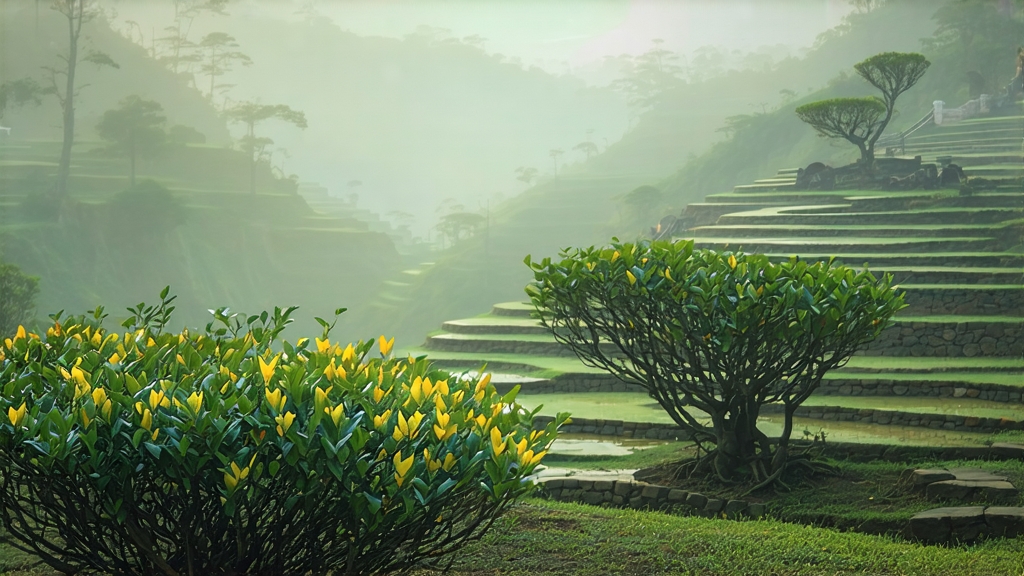
Tucked away in the cloud-veiled peaks of Ya’an, Sichuan, Mengding Huangya has been whispering its golden secret for more than twelve centuries. Foreign drinkers often greet yellow tea with a polite nod, mistaking it for a pale green cousin, yet one sip of Mengding Huangya silences the confusion: the liquor glows like late-afternoon sunlight on bamboo, the aroma drifts between fresh chestnut and steamed corn milk, and the taste lingers with a nectar-sweet coolness that leaves the palate feeling rinsed by mountain mist. To understand why this bud-only tea was once reserved for emperors—and why it almost vanished in the twentieth century—we need to walk the narrow stone paths of Mengding Mountain, where the first cultivated tea garden in China still survives.
Historical scrolls credit the Taoist monk Wu Lizhen with planting seven tea bushes on Mengding in 53 BCE, an act later celebrated as the birth of domesticated tea. By the Tang dynasty (618-907) the tender buds were pressed into cakes and rushed along the ancient Tea-Horse Road to Tibet, while the Song court (960-1279) declared Mengding tea a “tribute of the first rank,” demanding that each spring’s picking begin only after the provincial governor had burned incense and offered wine to the mountain spirits. When the Ming emperor abolished compressed tea in 1391, the mountain artisans invented the loose-bud style we now call Huangya, perfecting the slow “sealed yellowing” that turns green into gold. Caravans carried it to Lhasa, where nomads traded yak butter and horses for a leaf that smelled of Sichuan orchids; European missionaries sipping it in Chengdu during the 1880s sent home letters describing “a liquor of pale topaz that calms the blood.” Yet the twentieth century’s wars and communes pushed Mengding Huangya to the brink; the seven ancestral bushes survived only because local monks masked them among vegetable plots. When Chinese tea scholars rediscovered the technique in 1978, they found three old masters who still remembered the exact timing of the wrapped pile—knowledge now protected as national intangible heritage.
Mengding Huangya is not a single clone but a constellation of tiny micro-lots, each shaped by altitude, mist frequency, and the cultivar itself. The classic strain is the local “Mengding group” seedling population, a genetic mosaic of sinensis and var. pubilimba that develops a natural yellow tinge in early April. Above 1,000 m, the “Ganlu” sub-variant yields smaller buds with higher amino acids, giving a pronounced umami sweetness, while the lower slopes of 800 m produce broader buds richer in floral terpenes. Purists speak of three grades—Imperial (bud weight ≤0.5 g), Tribute (bud weight 0.5-0.7 g), and Gift (bud weight 0.7-1 g)—but mountain villagers add a fourth, “Monk’s Batch,” picked only after the Qingming festival when the buds have opened into tiny one-and-a-half-inch spears that steep into a creamier cup. Whatever the grade, the leaf must satisfy three visual tests: the bud should be straight like a silver needle yet show a faint yellow vein; the tip must feel velvety, not glossy; and when rubbed it should release the scent of fresh soybean milk.
The craft begins at dawn when the mountain temperature hovers around 10 °C and the dew is still evaporating in slow motion. Pickers—usually women whose families have worked the same terraces for generations—pluck only the bud and its half-open first leaf, dropping them into bamboo baskets lined with banana leaf to prevent bruising. By 9 a.m. the harvest is carried to the tiny village workshops where three sequential steps—shaqing (kill-green), menhuang (sealed yellowing), and wenhuang (warm yellowing)—unfold like a slow ballet. The buds are tossed by hand into iron pans heated to 160 °C for exactly 90 seconds; this deactivates the enzymes but leaves a whisper of moisture inside the bud. Immediately afterward the hot leaf is wrapped in thick parchment paper and slid into a bamboo steam chamber kept at 35 °C and 75 % humidity for 48 hours. Here the “yellowing” magic occurs: chlorophyll breaks down into pheophytin, catechins dimerize into theaflavins, and a mild oxidative aroma reminiscent